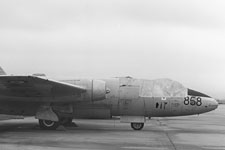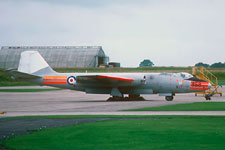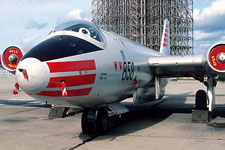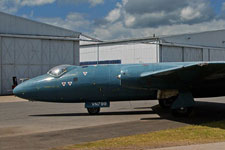| WJ874's service history
The English Electric Company built WJ874 as a Mk.4 Canberra for the Royal Air Force. Following the mandatory flight tests, the aeroplane was declared ready for collection 24th December 1954, but it did not immediately enter RAF service. It was instead held in reserve until January 1956 when it was issued to the RAF Binbrook Station Flight. Remaining in use at the Lincolnshire base for the next four years, WJ874 was then issued to the RAF Coningsby Station Flight on 1st January 1960. Unfortunately, at the time of writing it is not known how long it remained in use at Coningsby, but its next recorded Unit was No.231 Operational Conversion Unit (231OCU) at RAF Bassingbourn, where it remained in service until it was withdrawn and placed in store at RAF Shawbury 27 Maintenance Unit (27MU).
On 12th November 1969, WJ874 was officially transferred to Royal Navy charge following its arrival at Hurn airfield (now Bournemouth Airport) in Dorset, where it immediately commenced service with the civilian Fleet Requirements Unit (FRU). As aeroplane '847' WJ874 was operated on training duties for the two years with the FRU, under the care of Airwork Services Ltd until it was moved to RNAS Lee-on-Solent in November 1971 for maintenance. Modifications were then carried out by the Naval Air Radio Installation Unit (NARIU), and the airframe returned to Hurn for a short time before it was sent to RAF St Athan for a major airframe inspection on 3rd February 1972.
On 29th April 1974, WJ874 was re-introduced into Fleet Air Arm service following issue to the Fleet Requirements and Air Direction Training Unit (FRADTU) at RNAS Yeovilton. Still coded '847', the aeroplane remained in use for the rest of the year until it was flown to RAF Kemble for a paint re-finish on 12th December 1974. Three months later in February 1975, it was returned to Yeovilton and re-issued the fleet number '858'.
It was operated by FRADU (the word Training had been dropped during the previous year) for the next eleven years providing the Unit with a valuable dedicated pilot trainer, only broken up by periods of maintenance at 5MU Kemble (April-September 1979) and a full airframe refurbishment at Salmesbury via Warton (May 1980-November 1981). On 7th April 1986, WJ874 was withdrawn from FRADU service and was officially returned to the RAF at RAF Wyton with 231OCU.
Back in RAF ownership, WJ874 was promptly re-finished into camouflage and issued the identity code 'BM' which was applied on its tail fin. It re-commenced its all important pilot training role with 231OCU until the Unit was disbanded in April 1993. The aeroplane then passed to the combined RAF/Royal Navy Canberra Unit, RAF 360 Sqn at RAF Wyton, where it remained in use until October 1994 when that too was disbanded. All the Canberra T.4s left in service were then absorbed by RAF 39 (1 PRU) Squadron based at RAF Marham, and rotated between service and storage. WJ874 was re-coded 'AS' and was kept operational until its turn for a 'rest' at RAF Shawbury arrived in October 1995. However, just six months later it was back in service at Marham.
In April 1999, WJ874 was selected to represent the prototype Canberra VN799 to mark 50th Anniversary of the Canberra.
The aeroplane was moved to Bournemouth Airport for re-finishing by Flight Refuelling Ltd, and it soon emerged in the classic overall petter blue scheme as worn by VN799 on its first flight on 13th May 1949. It took centre stage in the birthday celebrations at BAe Warton, and was later displayed at several events during the 1999 airshow season, in between its regulation training duties with RAF 39 Sqn.
During the summer of 2004, WJ874 was sent for maintenance at Flight Refuelling Aviation at Bournemouth, and despite fears it would lose its blue scheme, it returned to RAF Marham in January 2005 looking exactly how it left. WJ874 made its last operational flight on 1st September 2005, and was offered for disposal shortly afterwards. |

[© Robin A. Walker]

[© Mike Freer]

[© Martin Morley]
|
WJ874's civilian life
WJ874 was bought by Mike Collett for his Air Atlantique Classic Flight collection. On 9th November 2005, the aeroplane was delivered to its new home at Coventry, with plans to re-introduce the airframe back onto the display circuit. It was registered G-CDSX in March 2006, but work gradually stopped and it was instead placed in open store at Coventry (when hangarage was not available).
With the planned move of Classic Flight to the former RAF St Mawgan airfield in Cornwall, WJ874 looks set to make the move south during the early part of 2013 and intially become a static exhibit at the newly renamed Classic Air Force collection.
During 2012, it was announced that the Classic Flight collection would move to the former RAF St Mawgan airfield in Cornwall
and become a Museum housing both static and airworthy aircraft.
WJ874 was dismantled at Coventry and moved by road to its new home, but the project was abandoned in late 2014
with the flyable airframes returning to Coventry.
As a static exhibit and the costs prohibitive to move the Canberra back to where
it came, it;'s future appeared bleak.
However, ownership of the airframe was transferred to to the Cornwall
Aviation Heritage Centre (CAHC), where a team of willing volunteers took on the
immense challenge to keep the remnants of the Museum going. As one of CAHC's larger exhibits, it is usually found on display outside, where it keeps two former FRADU Hunters company on the airfield (GA.11 WV256/862 and
T.8C WT722/878).
- April 2020
Links
- Cornwall Aviation Heritage Centre:



|

[© Brian Marshall]
|